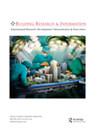改造净零建筑性能的评估:生命周期能源、排放和成本
IF 3.7
3区 工程技术
Q1 CONSTRUCTION & BUILDING TECHNOLOGY
引用次数: 0
摘要
摘要本研究旨在评估零能耗改造建筑(ZEB)的综合能源、环境和经济性能。进行了三个生命周期评估:生命周期能源(LCE)、生命周期碳排放(LCCE)和生命周期成本(LCC)。评估中使用了实际建筑施工成本数据和能源使用数据。分析结果表明,在整个建筑使用寿命期间,使用寿命阶段(B6)是LCE(82%)和LCCE(77%)的主要贡献者,而不是LCC(18%)。在生命周期内含碳(LCEC)中,A3是贡献最大的生命阶段(56%),主要与建筑组件的制造有关。本案例研究为ZEB在美国的表现提供了新的实证证据。研究结果表明,为了实现碳中和目标,目前的ZEB认证或指定不足以衡量实际建筑性能。除了减少制造过程中释放的内含碳外,还应进一步减少运营能源。本文章由计算机程序翻译,如有差异,请以英文原文为准。
An evaluation of the retrofit net zero building performances: life cycle energy, emissions and cost
ABSTRACT This study aims to assess the comprehensive energy, environmental and economic performance of a retrofit zero energy building (ZEB). Three life cycle assessments were conducted: life cycle energy (LCE), life cycle carbon emissions (LCCE) and life cycle cost (LCC). Actual building construction cost data and energy use data were used in the assessments. The analysis results indicated that during the whole building life span, the operational life stage (B6) was a major contributor to LCE (82%) and LCCE (77%), but not to LCC (18%). Within the life cycle embodied carbon (LCEC), A3 was the life stage with the highest contribution (56%), which is mainly related to the manufacturing of building assemblies. This case study provides new empirical evidence of ZEB performance in the United States. The findings suggest that to achieve the carbon neutrality goal, current ZEB certifications or designations are not adequate to measure actual building performance. A further reduction of operational energy, in addition to reducing the embodied carbon released during manufacturing, should be the focus.
求助全文
通过发布文献求助,成功后即可免费获取论文全文。
去求助
来源期刊

Building Research and Information
工程技术-结构与建筑技术
CiteScore
8.60
自引率
7.70%
发文量
43
审稿时长
>12 weeks
期刊介绍:
BUILDING RESEARCH & INFORMATION (BRI) is a leading international refereed journal focussed on buildings and their supporting systems. Unique to BRI is a focus on a holistic, transdisciplinary approach to buildings and the complexity of issues involving the built environment with other systems over the course of their life: planning, briefing, design, construction, occupation and use, property exchange and evaluation, maintenance, alteration and end of life. Published articles provide conceptual and evidence-based approaches which reflect the complexity and linkages between cultural, environmental, economic, social, organisational, quality of life, health, well-being, design and engineering of the built environment.
 求助内容:
求助内容: 应助结果提醒方式:
应助结果提醒方式:


